The Art of Cross-Making in Romania: A Synthesis of Tradition and Innovation
Romania, a land steeped in rich cultural traditions and religious observances, offers a captivating glimpse into the diverse ways communities express their faith. The creation of crosses, deeply symbolic within Christianity, becomes a particularly poignant artistic endeavor, manifested in remarkably different forms across the country. From the rustic charm of chainsaw-carved wooden crosses in Rãucesti to the ephemeral beauty of ice crosses sculpted in Galati, these practices encapsulate both the enduring power of tradition and the adaptability of craftsmanship in the face of changing circumstances. These distinct artistic expressions, though seemingly disparate, converge in their representation of profound religious devotion and cultural identity.
In the village of Rãucesti, nestled within Romania’s diverse landscape, the creation of wooden crosses stands as a testament to the enduring strength of traditional craftsmanship. Skillful artisans wield chainsaws, transforming raw timber into imposing two-meter-high crosses. This practice, likely passed down through generations, speaks to the deep connection between the community and their faith. The use of chainsaws, a relatively modern tool, demonstrates an intriguing blend of tradition and innovation. It allows for the efficient creation of large-scale crosses, while still retaining the rustic aesthetic inherent in working with wood. These crosses, likely erected in prominent locations within the village or in personal spaces, serve as constant reminders of spiritual values and anchors within the community. The scale of the crosses further emphasizes their significance, transforming them into striking visual representations of faith.
Meanwhile, in the city of Galati, situated along the Danube River, a different artistic expression takes shape with the carving of ice crosses. This practice, inherently tied to the annual Epiphany celebrations, demonstrates a unique adaptation to the natural environment. Local artisans skillfully sculpt 40kg blocks of ice into intricate crosses, showcasing a delicate artistry that contrasts with the robust wood carving of Rãucesti. The ephemeral nature of these ice crosses adds another layer of symbolism, reflecting the transient nature of earthly existence and the enduring spirit of faith. The weight of the ice blocks, a substantial 40kg, speaks to the physical effort and dedication involved in this artistic process, highlighting the reverence with which the artisans approach their craft.
The Epiphany celebration in Galati, centered around the Danube River, provides a vibrant backdrop for the display of these ice crosses. The faithful gather on the riverbanks, participating in the sacred water consecration, a ritual imbued with deep spiritual meaning. The throwing of the cross into the river by the Archbishop marks a climactic moment in the ceremony, followed by the spirited tradition of young men diving into the icy waters to retrieve it. This act of bravery and devotion symbolizes a spiritual rebirth and cleansing, echoing the baptismal significance of the Epiphany. The icy plunge into the Danube, a powerful symbolic gesture, highlights the enduring strength of faith and the willingness to embrace challenges in pursuit of spiritual renewal.
The evolution of ice cross carving techniques reflects a fascinating interplay between tradition and modernity. With the advent of warmer temperatures, likely due to climate change, maintaining the integrity of the ice crosses has become increasingly challenging. This has prompted the adoption of modern techniques, potentially involving refrigeration or specialized ice-making processes, to ensure the crosses remain solid throughout the Epiphany celebrations. This adaptation speaks to the resilience and resourcefulness of the community, demonstrating a commitment to preserving their traditions while acknowledging the realities of a changing world.
The distinct artistic traditions of cross-making in Rãucesti and Galati offer a compelling testament to the diversity of cultural expression within Romania. While the materials and methods differ, these practices share a common thread: they are deeply rooted in faith and serve as powerful expressions of community identity. The chainsaw-carved wooden crosses of Rãucesti embody permanence and tradition, while the ephemeral ice crosses of Galati reflect the transient nature of life and the enduring spirit of faith. Both practices, in their unique ways, contribute to the rich tapestry of Romanian cultural heritage. The adaptation of ice cross carving techniques further demonstrates the dynamic interplay between tradition and innovation, ensuring the continuation of these meaningful cultural practices in the face of environmental changes. The intersection of artistry, faith, and community is powerfully demonstrated in these Romanian traditions, creating a compelling narrative of resilience and adaptation.














